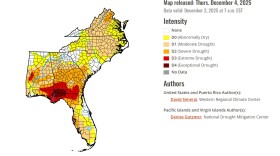LANCASTER, Pa. — The streets of this Colonial-era city are old and narrow, with blocks of 19th century brick rowhouses sitting just feet from the sidewalk.
That hasn't stopped Mayor Danene Sorace from making some 21st century changes — adding protected bike lanes and converting one-way streets to two lanes — in the name of safety.
"It's definitely slowed traffic," Sorace said last month as she led a walking tour for Transportation Secretary Pete Buttigieg to show off the changes the city is making.
The money to do this work, about $12 million, came from the federal Department of Transportation. Sorace says that's cut the time line for these projects in half.
"So what would have taken us 10 to 12 years is going to take us five to six," she said.
"Which really translates into lives saved," Buttigieg replied.
"Exactly," Sorace said.
The number of people killed on U.S. roads declined slightly last year — though the total was still over 40,000, well above pre-COVID pandemic levels. Pedestrian deaths also declined modestly after reaching a 40-year high in 2022.
Cities all over the country are trying to bring the numbers down further. And they're getting an influx of billions in federal funding from the bipartisan infrastructure law, much of it through a program called Safe Streets and Roads for All.
"Something like a bike lane is too often treated like a recreational bell and whistle," Buttigieg said during a press conference in Lancaster. "It is a lifesaving means to make transportation safer."

The money from these grants flows directly to cities, which means that projects can happen more quickly and in more places than ever before. But sometimes that's also accelerating conflict with local residents who don't like the sudden changes in their neighborhoods.
You can find them in Lancaster, just a few blocks away.
"It's awful," said Debbie Smithgall, who lives on Lancaster's west side. "They've taken all of our parking places away."
Smithgall is a vocal opponent of the city's new bike lanes. So was her late husband, former Lancaster Mayor Charlie Smithgall. She's particularly angry about the loss of parking on the corner in front of the pharmacy that the family owns. And Smithgall says the current mayor's office was not receptive.
"They didn't listen to one thing. Nothing. What the citizens had to say," Smithgall said. "They had their mind made up before they even got here."
Some of Smithgall's neighbors don't like the bike lanes, either. But some of them do, including Lee Shannon and Sarah Way, who live near the same corner.
"We both bike in the city a little bit, so it's nice to have a protected bike lane away from the traffic, which is good," Way said.
"I use it all the time. I default to that instead of my car, which is nice," Shannon said.
Way says they are a little sad about losing some parking spots. But both agree it's worth the trade-off.
"It is not that bad. People like to complain about parking," Shannon said. "There's plenty of parking."
Tensions like this are playing out across the country, in cities large and small, that are using this unprecedented outlay of federal cash to redesign dangerous streets and intersections.
"It's about saving lives," said Becky Daggett, the mayor of Flagstaff, Ariz., one of about a dozen city leaders who gathered during a meeting of the U.S. Conference of Mayors in Washington, D.C., earlier this year.
They met for nearly an hour with Buttigieg and other leaders at the Department of Transportation to talk about what they're doing to make their streets safer and how they navigate local pushback.
Flagstaff is using federal funding to install new protections for cyclists and pedestrians on one of her city's most dangerous roads, Daggett said, that's seen hundreds of crashes in recent years.
In Detroit, Mayor Mike Duggan said the city is using the federal money on a range of measures to calm traffic and protect pedestrians in a city that has long been dominated by the automobile.
"It all sounds boring, but it's critical," Duggan said. "Bump-outs. Refuge islands. Crosswalks. Signage and the like. It's going to make a huge difference."
Seattle Mayor Bruce Harrell says his city has been adding dozens of "No Turn On Red" signs, and local drivers are not happy about it.
"I have to tell you that when you take someone's ability to turn right away that is not an easy thing," Harrell said, as other mayors nodded in agreement.
For most of the meeting, Buttigieg listened quietly. Buttigieg, who was famously a mayor himself, acknowledged these road safety projects will not be popular with everyone.
"There is a politics to saving lives," Buttigieg said. But he urged local leaders to challenge the status quo anyway.
"We're investing the financial capital to do this. But I'm very mindful that you're investing political capital," Buttigieg told the mayors gathered in D.C. "And saving lives and tackling a crisis that claims as many American lives as gun violence is a really good use of that political capital."
The federal government can put up the money. But the political will to push for safer streets — that's something local leaders still have to find on their own.
Copyright 2025 NPR









